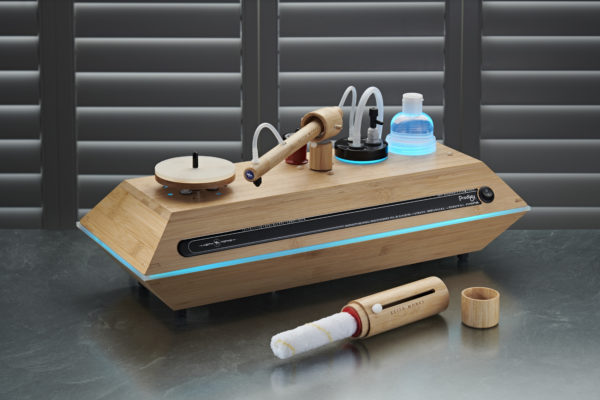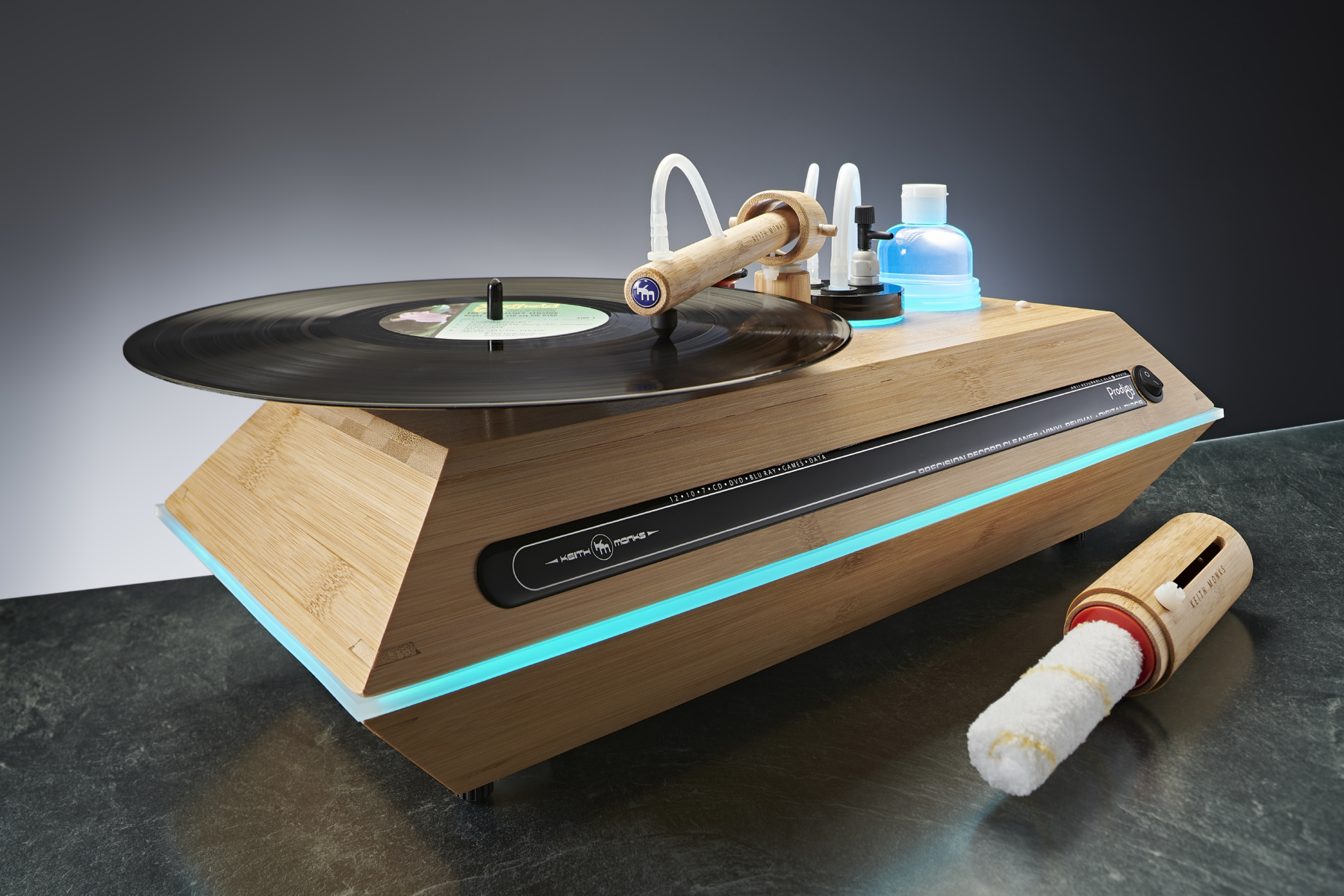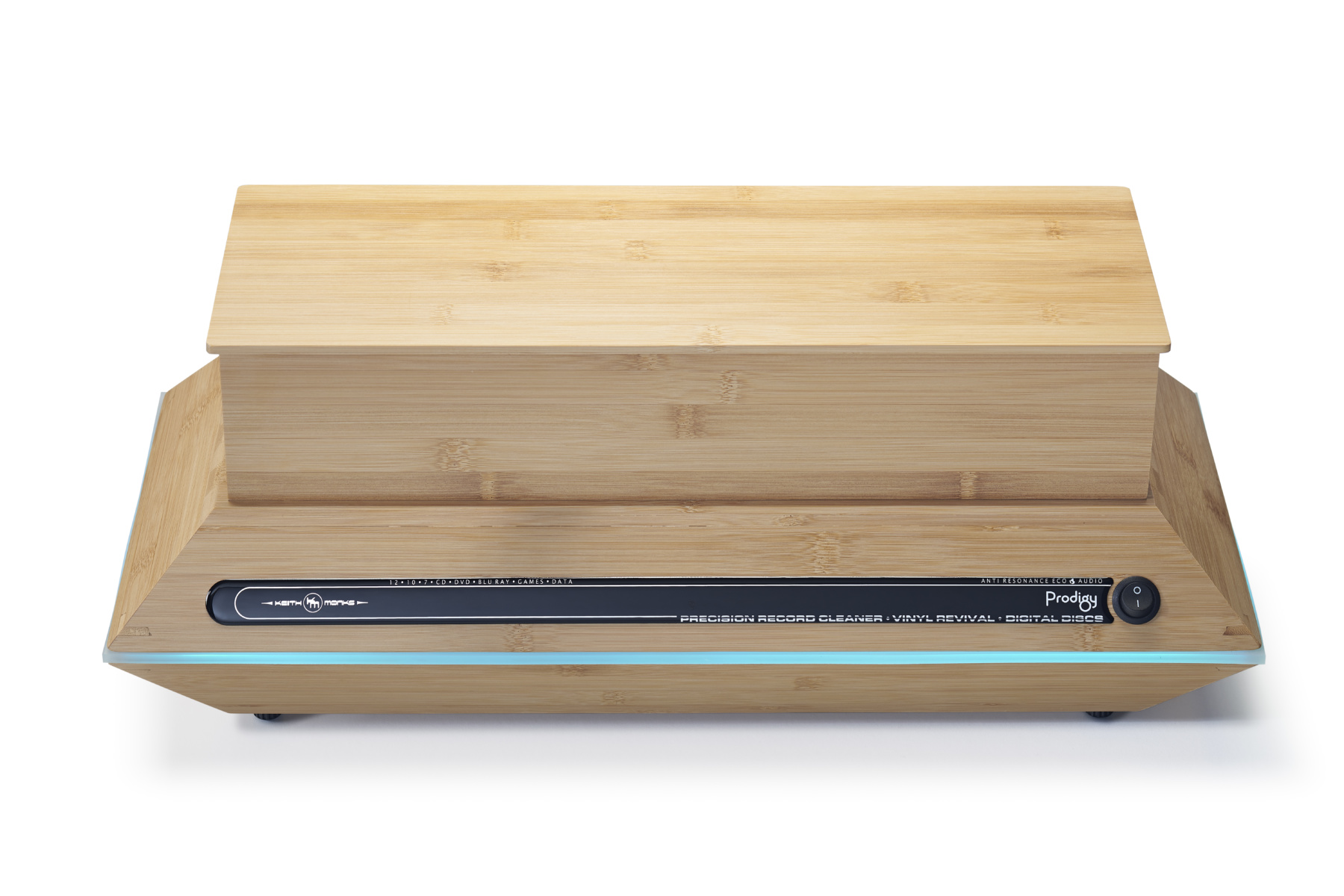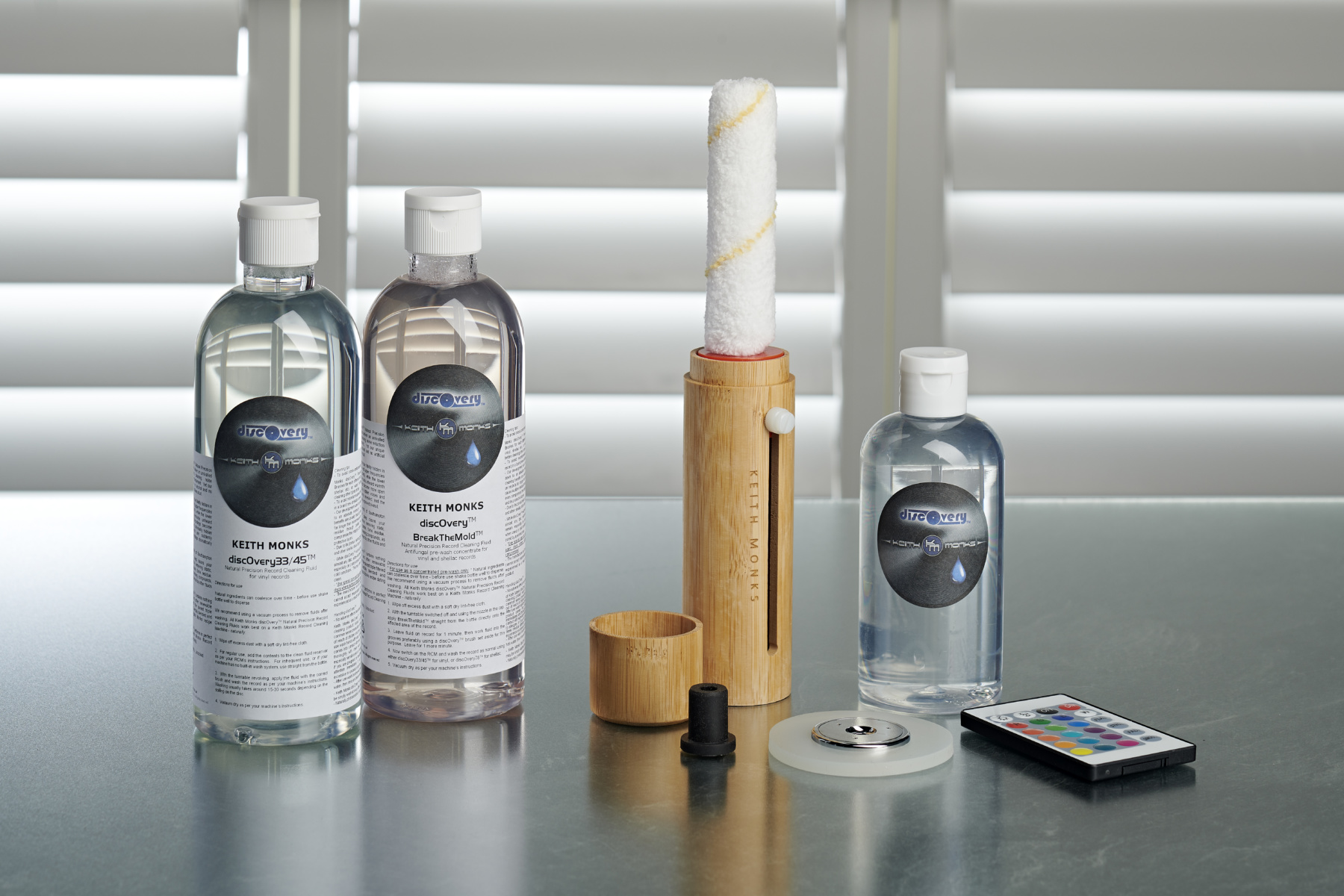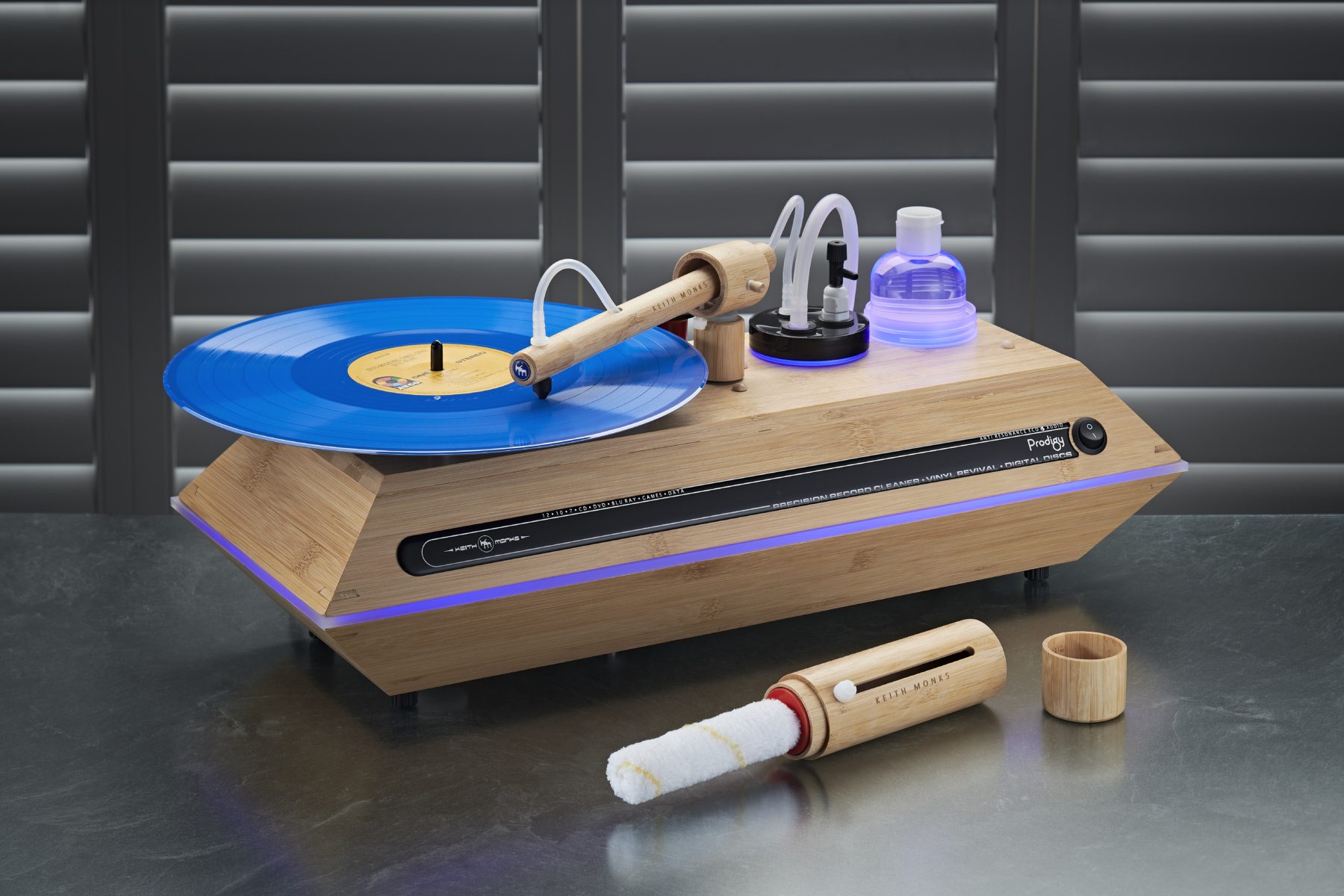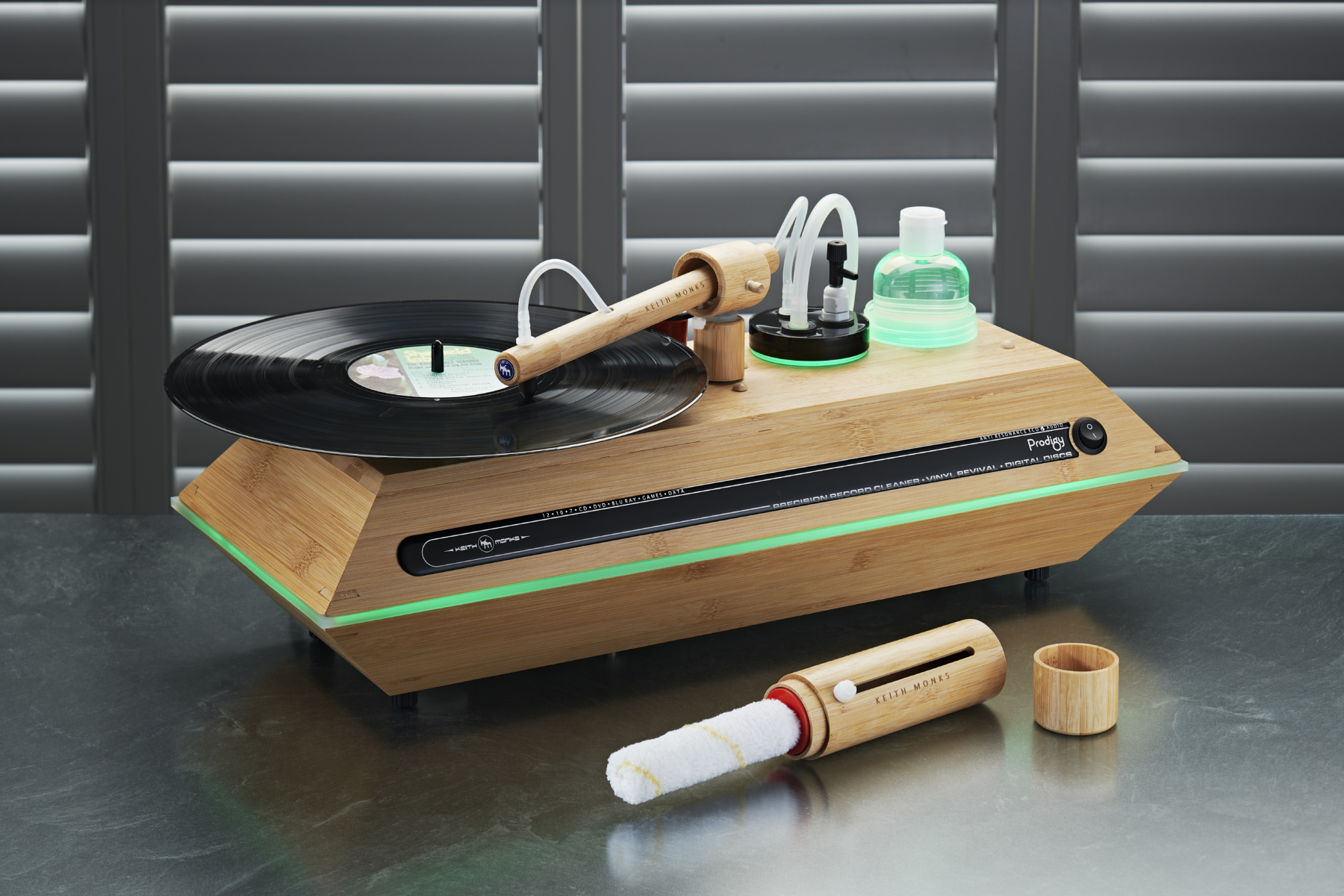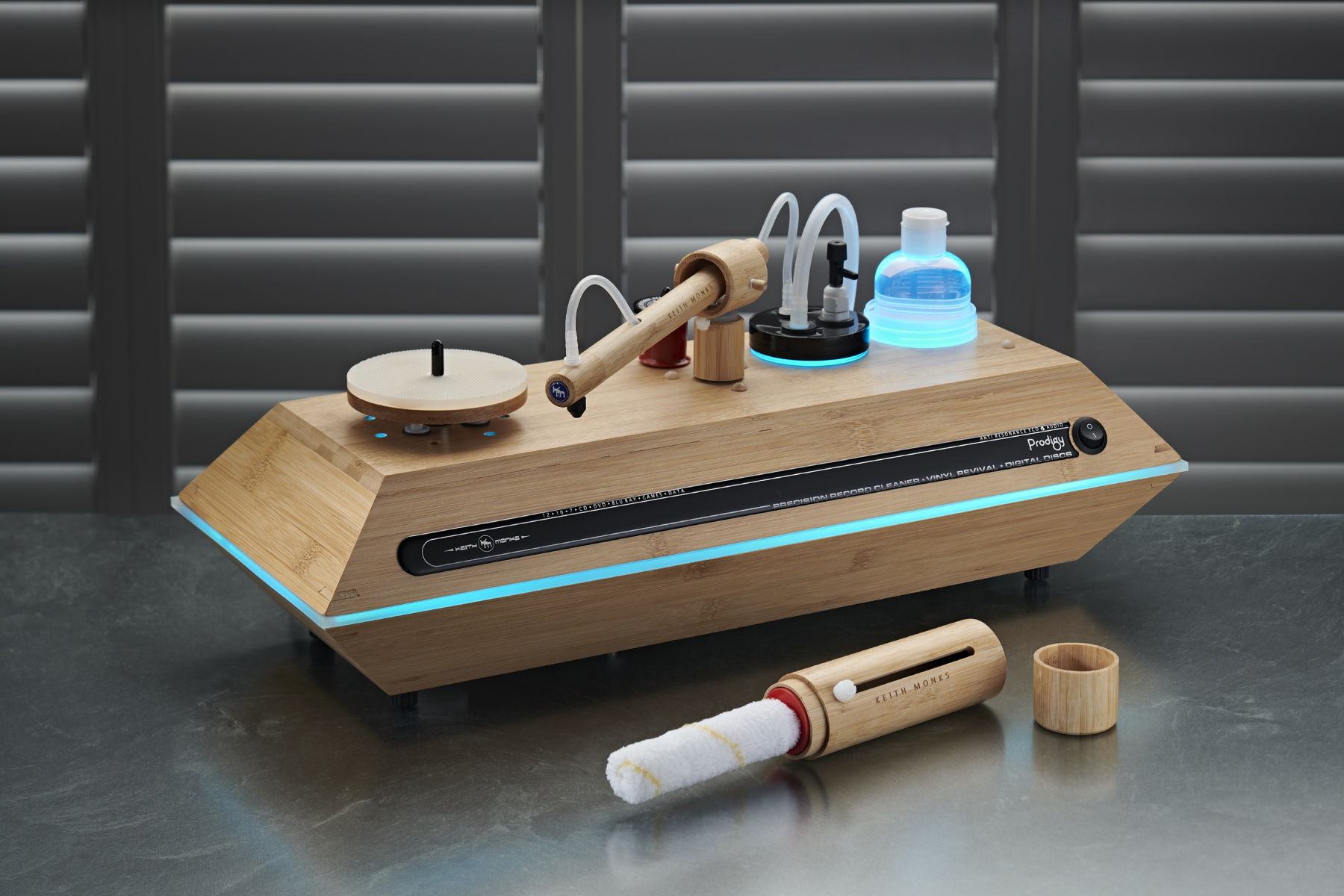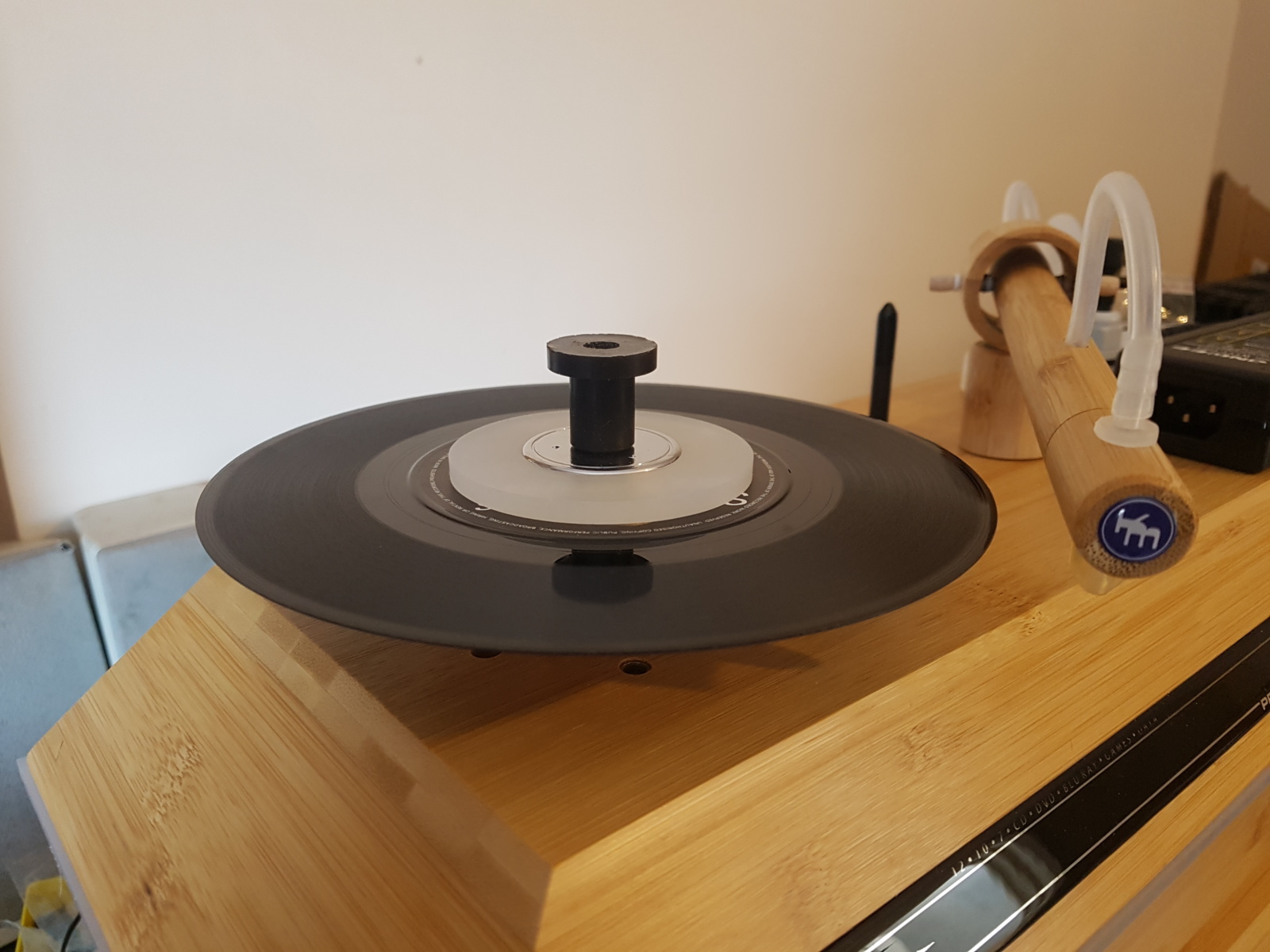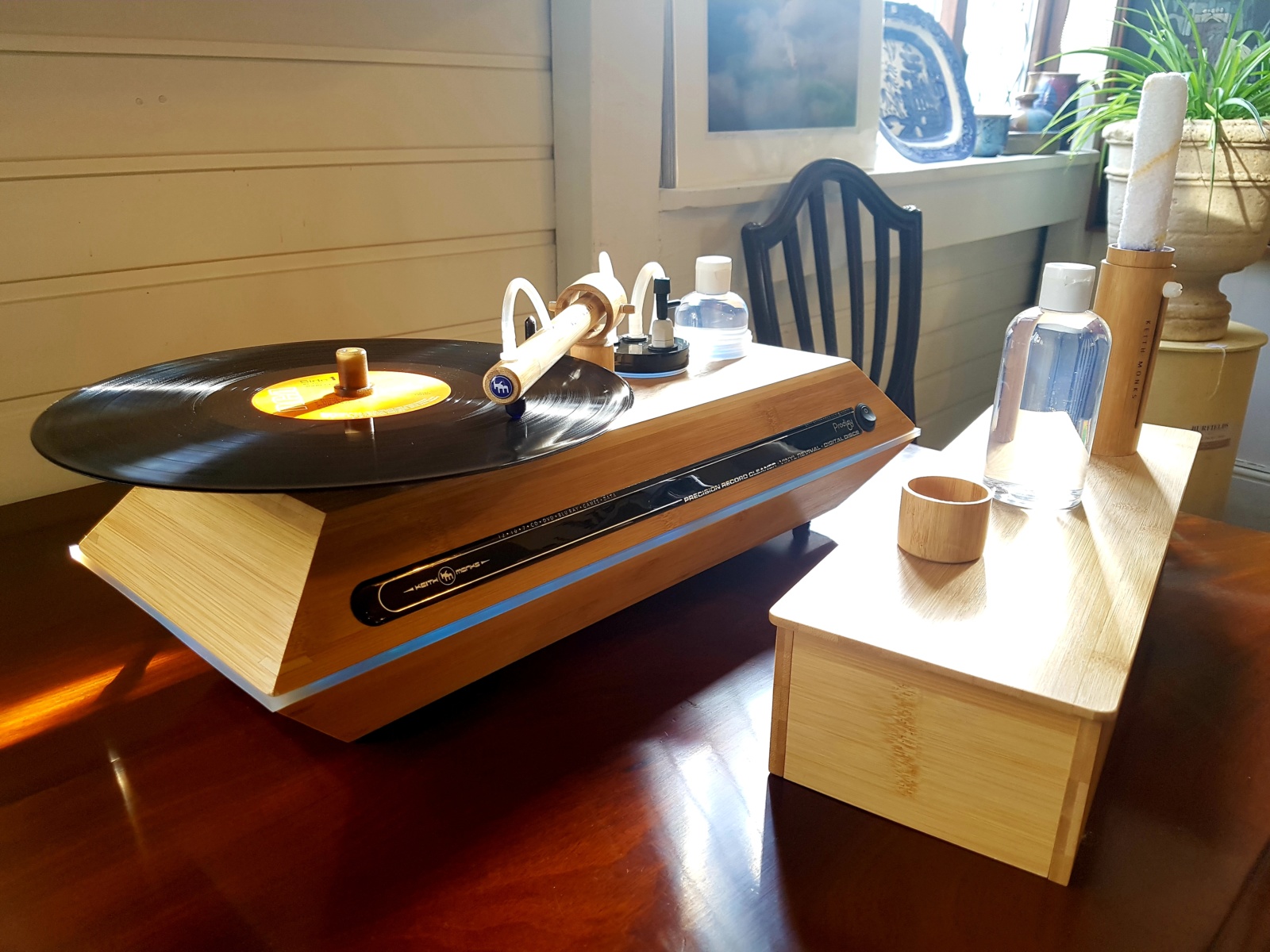About Keith Monks and what we do
What is “Precision Record Cleaning” ?
- A tiny precise suction tip, scanning across the disc a little at a time, removing every last trace of contaminated fluid – especially the mold release oils from the pressing stamper.
- Noise reduction is of course important, but removal of oils and residues is the biggest benefit of “proper” record cleaning.
- Removing oils from outgassed materials and excess mold release agents from the original manufacturing (newer audiophile pressings being a prime example) allows the stylus to track the groove more faithfully, optimising the clarity of sound, and allowing the rest of your wonderful system to really sing.
- Precision Record Cleaning restores and preserves your treasured records and also your precious stylus
- Safe, proven method and results
- Yes, “miracles do take a little longer” … but longer makes perfect. And with the auto shut off (Redux, microLight) or drop-down suction wand (Prodigy) for unattended cleaning, you really won’t notice.
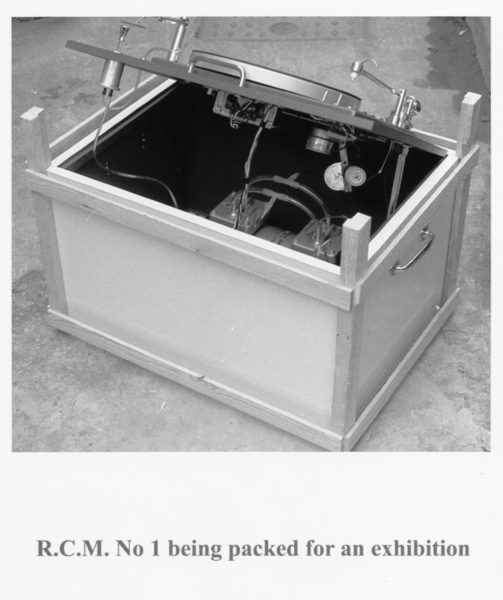
Zero Recontamination
- The teaspoon of fluid per record side is vacuumed away and never reused. No build up of oils in the reservoir tank and fluid, no damp pads redepositing contaminated fluids – your 100th record, just as clean as your first.
- We urge you, please – check out any other cleaner, and think about how it works … no other technique or brand can avoid these problems, or rightly claim such consistency and performance.
- Precision Record Cleaning cannot be done cheaply by cutting corners, nor by using “non-audio” industrial tech, microwaves and gadgetry … this is why the Keith Monks remains uniquely, Keith Monks
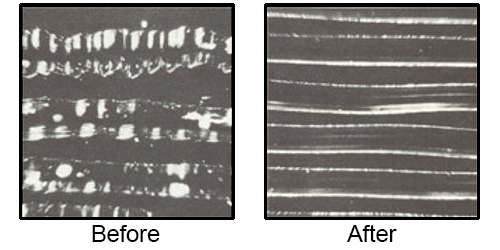
More Frequently Asked Questions
vinyldiscovery.com talks with Jonathan Monks, son of Keith.
Q What is the Keith Monks RCM’s link with the BBC ?
JM: without the BBC, the Keith Monks Record Cleaning Machine would never have gone into production. The original 1965 prototype design by Percy Wilson, Technical Editor of The Gramophone magazine, was then condensed down to a “compact” (2 foot / 60cm cube !) unit but it was only after Keith teamed up with radio engineers at Broadcasting House in London in 1967, with Percy as project consultant, that things started to really take shape. The BBC were rolling out their network of FM hi-fi stereo stations and the condition of their record library could no longer be hidden behind the static of AM. Over the following 18 months, everybody worked to produce what became the world’s first production machine for cleaning, restoring and preserving records, and this is what in many ways we still produce today. Technique, design, build and performance are all pretty much the same as the broadcast standard original, and all go into every machine we hand build here on the Isle of Wight in England, from the Prodigy upwards.
Q What makes the Monks Method so unique ?
JM: basically, Zero Recontamination – every record, every time.
I don’t believe in degrees of clean – it either is, or it isn’t. By that I mean, dry with all fluid removed along with the dislodged particles and dissolved residues including the mould release oils from the manufacturing used to get the record off the hot stamper.
This finally allows the stylus to track the groove faithfully, filling the resulting sound with warmth, depth and clarity – surely the most important benefit of effective record cleaning.
With Keith Monks, Zero Recontamination is high performance cleaning fluid to dissolve and dislodge, used just once then vacuumed away precisely, one turn at a time.
This is something other systems cannot claim – contaminated fluid is left on the cleaning parts and/or reused, and every time you clean a record, the parts and fluids will become more dusty and oily, leaving every subsequent record progressively less clean than the last.
Q What do you think about newer technologies ? Do they work ?
JM: honestly if you’re prepared to do a lot of recleaning of tools and emptying and refilling of fluids, you will probably get some results. But that’s a lot of work, and I still don’t see anything that can get close to washing and precise vacuuming, turn by turn.
We fine tune and improve but in essence, this is why we stick to what we do – not because we’re lazy or resting on our laurels, just because we haven’t found any idea that works any better.
I follow conversations and reports, online and from dealers. With our broadcast pedigree, proven quality and safety since 1969, and the universally documented chemical compatibility of our fluid ingredients, I am relieved I don’t have to worry about our process having any alleged long term effects of some methods on the record’s plasticizers, or even on the user, and I still cannot see how blow drying fluid around to make it evaporate does the same job as physically removing every last drop by precise vacuuming. But these we will have to put down to belief, if not simple common sense. Our process is transparent, simple to understand, tried and tested for over half a century. The customer has the choice – ultimately, in using a Monks, relaxing in the proven long term safety of the process on our precious collections, and then hearing the music that results, well I believe our results speak for themselves. And, actually enjoying doing the cleaning too !
Q What was the idea behind the Threadless design? Does it work better, or is it just eliminating the cost of replacing the thread ?
JM: previous generation Keith Monks models used a buffer thread to support the suction nozzle off the record and create an air space. The new unique Threadless tapered tip compresses the air to increase the velocity for additional fluids removal. This and the wider surface area of the tip effectively doubles the fluid pickup width for even drier records.
Why did we change it ? Because the only part of the Monks that
everybody hated having to deal with was the pesky thread ! Now we’ve removed the inconvenience and once set, improved the performance and results.
The thread also added an air of complexity that put off many less experienced people considering purchasing earlier machines.
It wasn’t a cost issue – it would fray and break, or get stuck in the arm tube. Just hard work, when the “sounds of silence” when using a Monks should give you anything but a headache.
Q One blogger’s reaction to Threadless was you’ve “dumbed down” the Monks …
JM: (big grin) hahaha yes I read that too – elitist much ?! I prefer to think of it as in the old adage, “simpler is better”. The types and grade of the four special polymers used in the Threadless tips are all impervious to contact with vinyl and vice versa. Set correctly and with the specially contoured tip shape, and with the correct type and amount of fluid, this allows direct contact without any contact issues or leaving residue. The discOvery fluid dislodges particles and dissolves oils but also acts as a lubricant, and the wider 360 degree suction not only allows the nozzle even more passes to vacuum up every last drop of contaminated fluid, it also self cleans the tip as it travels.
It’s then left to the adjustable air valve to simply regulate the suction and smooth the arm movement.
Perhaps some may say we are pandering to a more mainstream audience – I say yes, and I’m proud of it ! Broadcast/ Archive Standard record restoration and preservation should not be the sole reserve of the privileged few.
Let’s face it, any sort of cleaning of anything, most of us see as a chore. I’m determined that with a Monks, record cleaning (during as well as after) will always be a joy.
Q Are all Keith Monks machines now Threadless?
JM: Threadless has since proven so popular, we’re rolling it out across the range. We have models that present themselves at different price points in terms of appearance, features, and long daily use, but the improved effectiveness of Threadless remains complete, across the board.
We’re also making the Threadless system available as a retrofit kit – so existing KM users get the improvements we’ve developed for new customers. People have a lot of choice out there and we want to support those who have already supported us with their business. This way, nobody loses, and everybody can still benefit from having helped us get to where we are now.
Q How well does the Prodigy clean in comparison to your more upscale machines (putting speed aside) ? I think about potential cost cutting measures such as the motor and/or vacuum power.
JM: unlike the more upmarket Monks models the Prodigy is all 12V, but that hasn’t given us the compromises you might expect. The turntable and arm drive motor are just as torquey as the AC mains models. We need this for a good degree of wash scrubbing, and to resist the force of the suction at the nozzle tip.
The 12V vacuum pump is not quite as powerful as the medical pump from Germany in our bigger models but again, we don’t want to half-clean a record even on our entry model. So to achieve the same dryness, we simply slowed the vac arm down so it lingers on each part of the groove for longer.
Prodigy clean time is well under 3 minutes a side including the
washing; a Redux takes about half that time. The new Threadless point suction system developed for Prodigy further helps this along with double the pickup width at its soft nozzle tip.
Q How does the bamboo arm compare with the more upscale machines? Does it follow the groove better ?
JM: actually the Monks point suction (whether threaded or Threadless) doesn’t follow the groove at all. It spans from the inside outwards, following the centrifugal movement of the fluid.
The soft polymer tip and air regulation valve allows the nozzle to ride the record surface, precisely vacuuming one turn at a time.
The bamboo vac arm is of course lighter in weight than the aluminum on the upmarket models, which means it doesn’t need counterweighting. Also the anti resonant properties of bamboo isolates it from the pump and motors beneath, reducing noise, and making for a smooth glide for the arm across the record surface. Twin premium quality sealed ball bearings mounted top and bottom ensure a smooth movement of the lighter arm.
Q Prodigy Blue has some additional features (including auto shut off). Do you think it’s worth the price difference?
JM: Blue comes packaged with the discOvery 12 LP washing brush from the pro Monks models, its fine strands offering a deeper, faster scrub than with the Eco|Roller microfiber wand supplied with the entry model. So not better, just faster – and even quieter.
The natural finish bamboo cabinet is proving very popular, but some have found its appearance doesn’t match in with their high end set up, or may not be in keeping with their own home decor. The Keith Monks signature dark blue has an arguably more “audiophile” look to it – and the extra features are useful. So we offer the choice.
Q What prompted you to add the LED light show in Prodigy ? Ok it adds a bit of whimsy, but also seems superfluous. I mean, it doesn’t add to its cleaning capability, right ? And I assume it adds cost. What was your thinking in adding that feature?
JM: it adds about GBP11 / $15 cost all in – but its value is way greater than that. Again, we are making a conscious effort to appeal to a wider audience who complained the older boxes were too industrial. At this price point, for many families who will have to share their living space with a machine, home friendly becomes even more important. The quiet operation obviously helps, but it has to look the part too. Adding a focal point and ambient lighting in the room widens its appeal beyond the resident audio enthusiasts.
However the biggest reason for the lighting – especially set to color
changing – is to draw attention to the unit. The build, performance and quiet operation of Keith Monks machines offers a unique proposition to hi-fi and record stores wanting to offer a cleaning service for customers to come in and use themselves. The color changing makes people notice it, brings them over, they can use it maybe on records they just purchased. Then when they hear the results, they’ll want to bring in the rest of their collection.
Get people offline and into their local store, then keep them coming back. Obviously we want as many Prodigys as possible in as many stores as possible so yes, the lighting is part of a commercial decision beyond the function.
If you don’t like the lighting, that’s fine too – it has an off button !
Q The black bobbin on the deck – what purpose does it fulfil ?
JM: that’s where the thread reel used to sit. As I said, since 1969 and until recently, all Keith Monks models used a thread to cushion the nozzle off the record – this would be reeled out a little at a time. But it was fiddly and sometimes clogged up the tubes so for the new entry model, we developed a new soft tip instead.
Leaving the empty reel in its traditional spot is our tribute to the history of the world’s first Record Cleaning Machines, and to my dad.
Q Will I notice the difference compared to my old noisy cleaner?
JM: your family and neighbors will ! The only one to complain is your bottle of Advil / Anadin.
And as for the results, the muffled clouds will clear, and your music will sing as never before !
